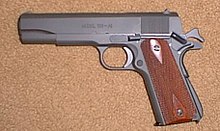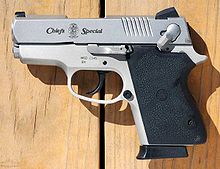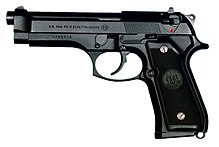Semi-automatic pistol
A semi-automatic pistol is a type of handgun that can be fired in semi-automatic mode, firing one cartridge for each pull of the trigger. This type of firearm uses a single chamber and a single barrel, which remain in a fixed linear orientation relative to each other while being fired and reloaded semi-automatically. Some terms that have been, or still are, used as synonyms for semi-automatic pistol are "automatic pistol", "self-loading pistol", "autopistol", and "autoloader".
A semi-automatic pistol functions by using the energy from the recoil of a single round of ammunition to extract and eject a fired cartridge from the pistol's chamber and load an unfired round from a magazine into the chamber for the next shot. Most types of semi-automatic pistols rely on a removable magazine for supplying new ammunition to reload the chamber to be able to fire the gun again. The removable magazine is typically located inside a hand grip.
Operation
Typically, the first round is manually loaded into the chamber by pulling back and releasing ("racking") the slide mechanism. After the trigger is pulled and the round is fired, the recoil operation of the handgun automatically extracts and ejects the shell casing and reloads the chamber. This mode of operation generally allows for faster reloading and storing a larger number of cartridges than a revolver, although semi-automatic pistols are potentially more prone to malfunctions than revolvers due to their more complex design and mechanism.

Some modern semi-automatic pistols are double action only (DAO); that is, once a round is chambered, each trigger pull will cock the hammer, striker, or firing pin, and will additionally release the same to fire a cartridge in one continuous motion. Each pull of the trigger on a DAO semi-automatic pistol requires the same amount of pressure. The Kel-Tec P-32 is an example of a DAO action. DAO semi-automatic pistols are most generally recommended only in the smaller, self-defense, concealable pistols, rather than in target or hunting pistols (a notable exception being Glock-brand competition pistols such as the G34 and G35 which are DAO, yet designed with low-strength sear connectors resulting in lightened trigger pulls to improve a shooter's accuracy). Standard modern semi-automatic pistols are usually double action (DA), also sometimes known as double-action/single-action (DA/SA). In this design, the hammer or striker may be either thumb-cocked or activated by pulling the trigger when firing the first shot. The hammer or striker is re-cocked automatically during each firing cycle. In double-action (DA) pistols, the first pull of the trigger requires roughly twice as much pressure as subsequent firings, since the first pull of the trigger also cocks the hammer (if not already cocked by hand). The Beretta 92F/FS, a full-sized, service, semi-automatic pistol is an example of this style of action. A common mode of carry for DA semi-automatic pistols is with the magazine full, a round chambered, and the gun holstered and uncocked with the external safety unengaged or off.

In contrast, a single-action (SA), semi-automatic pistol must be cocked by first operating the slide or bolt, or, if a round is already chambered, by cocking the hammer manually. The famed Colt M1911 is an example of this style of action. All SA semi-automatic pistols exhibit this feature, and automatically cock the hammer when the slide is first "racked" to chamber a round. A round can also be manually inserted in the chamber with the slide locked back. Then the safety applied.
Cocking modes
The normal mode of carrying an SA semi-automatic pistol is Condition 1, popularly known as cocked and locked (see photo of Springfield Armory M1911A1 above). Condition 1 (a term popularized by Colonel Jeff Cooper) refers to having the magazine full, a round chambered, the hammer fully cocked, and the thumb safety engaged or on, at least for right-handed users. For many single-action, semi-automatic pistols, this procedure works well only for right-handed users, as the thumb safety is located on the left side of pistol and is easily accessible only for those who are holding the pistol in the right hand.
On many SA semi-automatic pistols, there is also a hammer position known as "half-cocked". Squeezing the trigger will not fire the gun when it is in the half-cocked position, and neither will dropping the gun in this state cause an accidental discharge. During WWII in the Pacific Theater, an unofficial and unapproved carry mode for the SA M1911 by left-handed US soldiers in combat was carrying the gun with the magazine full, a round chambered, the action in half-cocked position, and the thumb safety (accessible only to right-handed users) positioned in the off (or ready-to-fire) mode.
The primary advantage of the half-cocked position versus the uncocked position in that particular scenario was added sound suppression (of the click of the weapon being cocked). A secondary advantage was the avoidance of accidental discharges if the gun were accidentally dropped. The half cock was revised by Colt in the 1970s and subsequently other manufacturers - the hammer will fall from half cock if the trigger is pulled on most newer 1911 type guns.
do a barrel role the 1Cocking the gun from uncocked to fully cocked was much noisier than turning the niger safety off for right-handed users, or cocking the gun from half cocked to fully cocked for left-handed users. In general, single-action, semi-automatic pistols should never be carried uncocked with the safety off, although many newer SA pistols have modified actions which allow the hammer to exert pressure against the firing pin only when the trigger is pulled. Many modern SA semi-automatic pistols have had their safety mechanisms redesigned to provide a thumb safety on both sides of the pistol (ambidextrous), thereby better meeting the needs of left-handed as well as right-handed users.
There also have been notable semi-automatic pistol designs with different traits than those generally described here, including those with a magazine fed with a stripper clip, and those with non-removable (sometimes called "blind-box") magazines. These designs are rarely used in modern semi-automatic pistols. The Model C96, or "Broomhandle" Mauser, in its original configuration, has a fixed, non-removable magazine located in front of the trigger, which is loaded directly through the breech from the top of the pistol, in contrast to most contemporary pistol designs.
Semi-automatic pistols utilize one firing chamber that remains fixed in a constant linear position relative to the gun barrel. In contrast, although double-action revolvers can also be fired semi-automatically, their rounds are not fired from a single chamber, but rather are fired from each of 5 to 10 chambers, with 6 chambers being the most common, that are rotated into linear alignment with the barrel's position in turn just prior for each shot fired.
The language surrounding automatic, semi-automatic, self-loading, etc., often causes confusion due to differences in technical usage between different countries and differences in popular usage. For example, the term "automatic pistol" technically refers to a machine pistol which is capable of firing multiple round bursts for a single pull of the trigger, although in popular US usage it is also used as a synonym for a semi-automatic pistol. In the case of pistols, an 'automatic pistol', a 'semi-automatic pistol', or a 'self-loading pistol', all usually imply a handgun that is semi-automatic, self-loading, and magazine-fed with a magazine that is removable, producing one shot fired for each trigger pull. The term pistol may refer to handguns in general, or may be used to differentiate (semi-automatic) pistols from revolvers.
Technology
A self-loading pistol reloads the chamber with a new round automatically each time the weapon is fired, without additional action being required by the user. For a semi-automatic pistol, this is typically accomplished by recoil operation. For a machine pistol, in contrast, this can be accomplished by blowback, or, less commonly, by harnessing gases produced when the gun is fired. See the Desert Eagle for an example of a semi-automatic pistol that does siphon off some of the gases instead of relying on short recoil operation. See Gas-Operated article for details on gas operation of firearms. A semi-automatic pistol will fire only one shot per trigger pull, in contrast to a "fully automatic" or machine pistol, which continues to fire as long as the trigger is held or until all rounds have been fired.
While both types of weapons operate on the same principles, fully automatic weapons must be built more ruggedly to accommodate the heat and stress caused by rapid firing, and it can be difficult (and illegal in most countries) to convert a semi-automatic pistol into a fully automatic mode of fire. A selective fire action pistol, though, can be converted back and forth by means of a switch, and often includes burst mode (typically for three-round bursts for each trigger pull). Selective-fire weapons are generally used by specialized law enforcement and security personnel such as SWAT teams, hostage rescue teams, anti-terrorist units, or government bodyguards for heads of state. Selective-fire weapons are not available to civilians unless (in the US) they live in a state that allows civilian ownership of National Firearms Act(NFA), or Class 3 weapons. The Mauser M712 Schnellfeuer (German for "rapid fire"), a later variant of the Mauser C96 pistol mentioned above, is a notable example of a true machine pistol.
Actions: blowback vs. locked breech
Self-loading automatic pistols can be divided into "blowback" and "locked breech" categories according to their principle of operation. This classification roughly divides the operation into those specifically suitable for small-caliber versus large-caliber semi-automatic pistols.
Trigger mechanisms
A trigger is a mechanism that actuates the firing sequence of firearms. Triggers almost universally consist of levers or buttons actuated by the index finger. Firearms use triggers to initiate the firing of a cartridge in the firing chamber of the weapon. This is accomplished by actuating a striking device through a combination of spring and kinetic energy operating through a firing pin to strike and ignite the primer. There are two primary types of striking mechanisms, hammers and strikers.
Hammers are spring-tensioned masses of metal that pivot on a pin when released and strike a firing pin to discharge a cartridge. Strikers are, essentially, spring-loaded firing pins that travel on an axis in-line with the cartridge eliminating the need for a separate hammer. The connection between the trigger and the hammer is generally referred to as the sear surface. Variable mechanisms will have this surface directly on the trigger and hammer or have separate sears or other connecting parts.
There are numerous types of trigger mechanisms. They are categorized according to which functions the trigger is to perform. In addition to releasing the hammer or the striker, a trigger may cock the hammer or striker, rotate a revolver's cylinder, deactivate passive safeties, select between semi-automatic and full-automatic fire such as the Steyr AUG, or pre-set a 'set trigger.' Most modern firearms use the trigger to deactivate passive safeties but this does not change how they are identified.
History
After Hiram Maxim introduced his recoil-powered machine gun in 1883, several gunsmiths set out to apply the same principles to handguns, including Maxim. Maxim's designs for smaller firearms using his recoil-powered ideas never went into production. In the 1880s, other designers worked on self-loading designs. The first model to gain any commercial success was the Hugo Borchardt-designed self-loading Borchardt C-93 semi-automatic pistol, which was designed in 1893 and made its public appearance in 1894. Borchardt invented the C-93 mechanism, but it was based in large part upon Maxim's toggle-lock principle. The C-93 featured a clever locking mechanism modeled after the human knee joint in which the mechanical joint is called a knee, or in German Kniegelenk (knee joint).
The C-93 proved mechanically reliable, but was too large and bulky to receive widespread acceptance. Equipped with a screw-on wooden stock, the C-93 served well in small pistol carbines, however. Borchardt also developed the 7.65 x 25 mm Borchardt cartridge, around which the C-93 was built.
In 1896, Paul Mauser introduced his first model of the famous Mauser "Broomhandle" semi-automatic pistol, the C96. Using the powerful 7.63 mm bottle-necked cartridge originally designed by Borchardt, the Mauser was the first self-loading pistol used extensively in battle, notably the South African War of 1899-1902. These pistols were made in 7.63x25mm_Mauser along with some models eventually being made in 9 x 19 mm Parabellum (9 x 19 mm Luger) and a small number in .45 ACP.
In the United States in 1896, the first American gun designer to develop self-loading semi-automatic pistols was John Browning, whose models were manufactured by Colt in the US, and by the Belgian firm of Fabrique Nationale (FN) in Europe. Like Luger's work conducted around the same time in Germany, Browning's first successful design was in 7.65 mm caliber, the Browning M1900. Browning also devised a slightly different 7.65 mm Browning (.32 Auto, 7.65x17mm SR) cartridge for his .32 caliber semi-automatic pistol that differed from Luger's 7.65 mm Luger (.30 Luger, 7.65 x 21 mm) cartridge. Browning also designed .25 ACP, .380 ACP, and .45 ACP cartridges in addition to .32 ACP cartridges for his semi-automatic pistol designs.
He also created the locked-breech action now commonly used by nearly all heavy-caliber semi-automatic pistols, and designed the .45 ACP Colt M1911 single-action semi-automatic pistol, which was adopted by the US military in 1911 (hence the Model 1911 designation) and which remained in service for over 70 years. The Model 1911 is still in active use with some US Special Forces and Marine Corps units.
Browning also co-designed the FN Browning Hi-Power, announced in 1922, during the last years of his life, working on this design until his death in 1926. It was a 9 mm Para semi-automatic pistol and was the first high-capacity, semi-automatic pistol design to feature a staggered-column magazine capable of holding 13 rounds (plus one chambered) in place of the single column magazine that Browning had favored in designing the earlier .45 ACP Colt M1911. (The earlier, single-column magazine design is still used to today, however, especially for deep-concealment semi-automatic pistols such as the Kel-Tec P-32.)
The next notable design was the 7.65 mm Luger by Georg Luger, which although successful in its function, nonetheless failed to have adequate stopping power and failed to win widespread acceptance. In 1902, Georg Luger's subsequent and similar 9 mm Luger Parabellum (9 x 19 mm) Pistole Parabellum design overcame the problem of inadequate stopping power and featured a greatly improved Borchardt-type Kniegelenk ("knee-joint") locking mechanism. Unlike Browning's locked-breech design, the barrel in a Kniegelenk design does not tip up and down while the gun is fired, thereby theoretically improving shooting accuracy. Luger's 9mm Pistole Parabellum design was adopted by the German military and served as their standard sidearm during World War I. During World War II, Germany was the first nation to adopt a double-action pistol, the Walther P38 which could be carried loaded (with a cartridge chambered) and ready to fire without the risk of an accidental discharge if dropped. The P38 likewise used Luger's 9 mm Parabellum (9 mm Luger) cartridge.
During World War II, the only major powers to still use military revolvers as sidearms were Britain, the Soviet Union, and the United States. Though the British firm Webley and Scott had developed several adequate self-loading pistols, one of which was adopted by the British Police in 1911 and by the Royal Navy and Royal Marines before the First World War, revolvers were generally preferred by most British military. In the Soviet Union, the TT pistol replaced the Nagant M1895 revolvers during the war. In the United States, though, the Colt M1911A1 semi-automatic single-action pistol was adopted as the standard military sidearm. Both Colt and Smith & Wesson produced revolvers chambered for the same .45 ACP pistol ammunition used in the M1911A1, because of the great demand for handguns and the need to adopt a common cartridge for use among semi-automatic pistols and revolvers.
After World War II, most nations eventually adopted 9 mm Luger (9mm Parabellum) caliber pistols employing Browning's locked-breech design for their standard-issue military pistols. The most popular early choice was the previously mentioned FN Browning Hi-Power, which was the first high-capacity pistol; another popular model was the locked-breech Walther P38 because of its many modern safety features. The current U.S. military sidearm is a variant of the Beretta 92F/FS.

In 1971, Smith & Wesson offered a safe double-action, high-capacity pistol with its Model 59. CZ launched its CZ-75 in 1975. Beretta introduced its Beretta 92 in 1976. Glock introduced the groundbreaking Glock 17 in 1982, and SIG-Sauer introduced its model SIG P226 in 1983. In the early 90s, Heckler & Koch combined what they thought were the most desirable attributes of semi-autos in their pistol, the HK USP. In 1995, Kel-Tec introduced their first compact 9mm Parabellum pistol, the Kel-Tec P11, designed for concealed carry. In 1999, Kel-Tec introduced their extremely popular .32 ACP P-32 for deeply concealed carry. Both of the Kel-Tec pistols are double-action-only (DAO) designs.
After the Second World War, the almost universal trend has been for self-loading, semi-automatic pistols to replace revolvers for military use, although the transition has been slower among police and civilian use. Today, revolvers are mainly used for civilian self-defense, hunting, plinking, and target practice. Semi-automatic pistols, though, are becoming by far the most popular for deeply concealed carry by licensed civilians, for use as primary handguns for police and military use, for use as backup guns for police use, and for use where the 5 or 6 shots of a revolver are deemed inadequate.
